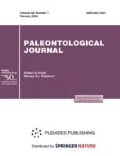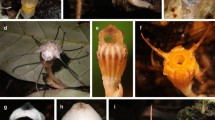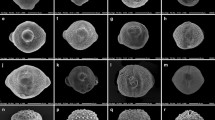Abstract
Changes in three pollen grain characters: number of sacci, infrastructure of sacci, and number and position of apertures, are considered against a phylogenetic background of cordaites and early conifers reconstructed on the basis of female fructifications. Bisaccate pollen grains with double germination developed most probably independently in Majonicaceae and Voltziaceae, whereas the most primitive conifers produced monosaccate prepollen with a single proximal aperture. Another lineage resulting in true pollen with a single distal aperture can be observed within cordaites. The development of saccus infrastructure among early pinopsids was directed from eusaccus to protosaccus rather than vice versa. In any case, the eusaccus of modern conifers is not homologous to that of cordaites and its origin is to be elucidated. The pollen characters suggest a very early separation of conifers from cordaites, approximately simultaneous with the division of cordaites into three families.
Similar content being viewed by others
References
S. A. Afonin, “Pollen Grains of the Genus Cladaitina Extracted from the Gut of the Early Permian Insect Tillyardembia (Grylloblattida),” Paleontol. Zh., No. 5, 105–109 (2000) [Paleontol. J. 34 (5), 575–579 (2000)].
B. E. Balme, “Fossil In Situ Spores and Pollen Grains: An Annotated Catalogue,” Rev. Palaeobot. Palynol. 87, 81–323 (1995).
W. G. Chaloner, “The Evolution of Miospore Polarity,” Geoscience and Man 1, 47–56 (1970).
J. A. Clement-Westerhof, “Aspects of Permian Palaeobotany and Palynology, IV. The Conifer Ortiseia Florin from the Val Gardena Formation of the Dolomites and the Vicentinian Alps (Italy) with a Revised Concept of the Walchiaceae (Göppert) Schimper,” Rev. Palaeobot. Palynol. 41, 51–166 (1984).
J. A. Clement-Westerhof, “Aspects of Permian Palaeobotany and Palynology, VII. The Majonicaceae, a New Family of Late Permian Conifers,” Rev. Palaeobot. Palynol. 52, 375–402 (1987).
J. A. Clement-Westerhof, “Morphology and Phylogeny of Palaeozoic Conifers,” in Origin and Evolution of Gymnosperms, Ed. by C. B. Beck (Columbia Univ. Press, New York, 1988), pp. 298–337.
A. F. Dibner, “Pollen of Cordaiteans of Angaraland,” Uch. Zap. NIIGA, Paleontol. Biostrat., Issue 32, 5–66 (1971).
R. Florin, “Die Koniferen des Oberkarbons und des unteren Perms,” Palaeontogr. Abt. B 85, 1–729 (1938–1945).
A. V. Gomankov, “’Pseudoconifers’ and Their Position in the System and Phylogeny of Early Pinopsids,” in Abstracts of the Collection of Papers in Commemoration of S.V. Meyen (Geol. Inst. Ross. Akad. Nauk, Moscow, 1997), pp. 12–13 [in Russian].
A. V. Gomankov, “On Pollen Evolution in Gymnosperms in General and Pinopsids in Particular,” Paleontol. J. 34(Suppl. 1), S14–S19 (2000).
A. V. Gomankov and A. S. Khoroshavina, “New Data on Morphology and Geographic Distribution of Sashinia (Conifers) from the Upper Permian of the Russian Plate,” Byull. Mosk. Ob-va Ispyt. Prir., Otd. Geol. 74(2), 49–53 (1999) [in Russian].
A. V. Gomankov, B. E. Balme, and C. B. Foster, “Tatarian Palynology of the Russian Platform: A Review,” Proc. R. Soc. Victoria 110, 115–135 (1998).
L. Grauvogel-Stamm, “La flore du Grès a Voltzia (Buntsandstein supérior) des Vosges du Nord (France). Morphologie, anatomie, interprétations phylogénique et paléogéographic. Mém. Université L. Pasteur de Strasbourg, Institut de Géologie, 50, 1–225 (1978).
G. R. Hernandez-Castillo, G. W. Rothwell, and G. Mapes, “Thucydiaceae fam. nov., with a Review and Reevaluation of Paleozoic Walchian Conifers,” Int. J. Plant Sci. 162, 1155–1185 (2001).
J. H. F. Kerp, and J. A. Clement-Westerhof, “Aspects of Permian Palaeobotany and Palynology, XII. The Form-Genus Walchiostrobus Florin Reconsidered,” Neues Jahrbuch für Geologische und Paläontologische Abhandlungen. 183, 257–268(1991).
J. H. F. Kerp, R. J. Poort, H. A. J. M. Swinkels, and R. Verwer, “Aspects of Permian Palaeobotany and Palynology, IX. Conifer-Dominated Rotliegend Flora from the Saar-Nahe Basin (?Late Carboniferous-Early Permian; SW Germany) with Special Reference to the Reproductive Biology of the Earliest Conifers,” Rev. Palaeobot. Palynol. 62, 205–248 (1990).
N. A. Koloda, “New Advances in the Systematics of Permian Quasimonosaccate Pollen,” Tr. Inst. Geol. Komi Nauchn. Tsentra Ural. Otd. Ross. Akad. Nauk, Issue 89, 49–59 (1996) [in Russian].
H. K. Maheshwari and S. V. Meyen, “Cladostrobus and the Systematics of Cordaitean Leaves,” Lethaia 8, 103–123 (1975).
G. Mapes, “Ovule Inversion in the Earliest Conifers,” Am. J. Bot. 74, 1205–1210 (1987).
G. Mapes and G. W. Rothwell, “Permineralized Ovulate Cones of Lebachia from Late Palaeozoic Limestones of Kansas,” Palaeontology 27, 69–94 (1984).
G. Mapes and G. W. Rothwell, “Structure and Relationships of Primitive Conifers,” Neues Jahrbuch für Geologische und Paläontologische Abhandlungen. 183, 269–287 (1991).
N. R. Meier-Melikyan, S. A. Afonin, and A. V. Gomankov, “Ultrastructure of Pollen Grains of Some Conifers from the Permian Deposits of the Russian Platform,” Bot. Zh. 83(3), 1–8 (1998) [in Russian].
S. V. Meyen, “The Carboniferous and Permian Floras of Angaraland (a Synthesis),” Biol. Mem. 7, 1–109 (1982).
S. V. Meyen, “Basic Features of Gymnosperm Systematics and Phylogeny As Shown by the Fossil Record,” Bot. Rev. 50, 1–111 (1984).
S. V. Meyen, Fundamentals of Palaeobotany (Chapman and Hall, London-New York, 1987).
S. V. Meyen, “Permian Conifers of Western Angaraland,” Rev. Palaeobot. Palynol. 96, 351–447 (1997).
M. A. Millay and T. N. Taylor, “Morphological Studies of Paleozoic Saccate Pollen,” Palaeontogr. Abt. B 147, 75–99 (1974).
M. A. Millay and T. N. Taylor, “Evolutionary Trends in Fossil Gymnosperm Pollen,” Rev. Palaeobot. Palynol. 21, 65–91 (1976).
R. J. Poort, H. Visscher, and D. L. Dilcher, “Zoidogamy in Fossil Gymnosperms: The Centenary of a Concept, with Special Reference to Prepollen of Late Paleozoic Conifers,” Proc. Natl. Acad. Sci. USA 93, 11713–11717 (1996).
R. J. Poort, J. A. Clement-Westerhof, C. V. Looy, and H. Visscher, “Aspects of Permian Palaeobotany and Palynology. XVII. Conifer Extinction in Europe at the Permian-Triassic Junction: Morphology, Ultrastructure and Geographic/Stratigraphic Distribution of Nuskoisporits dulhuntyi (Prepollen of Ortiseia, Walchiaceae),” Rev. Palaeobot. Palynol. 97, 9–39 (1997).
G. W. Rothwell and G. Mapes, “Barthelia furcata gen. et sp. nov., with a Review of Paleozoic Coniferophytes and a Discussion of Coniferophyte Systematics,” Int. J. Plant Sci. 162, 637–667 (2001).
G. W. Rothwell, G. Mapes, and G. R. Hernandez-Castillo, “Hanskerpia gen. nov. and Phylogenetic Relationships among the Most Ancient Conifers (Voltziales),” Taxon 54, 733–750 (2005).
B. W. Scheuring, “’Protosaccate’ Strukturen, ein weitverbreitetes Pollenmerkmal zur früheren und mittleren Gymnospermenzeit,” Geologische und Paläontologische Mitteilungen, Innsbruck 4, 1–30 (1974).
T. N. Taylor and L. Grauvogel-Stamm, “The Ultrastructure of Voltzialean Pollen,” Rev. Palaeobot. Palynol. 84, 281–303 (1995).
N. E. Zavialova and A. V. Gomankov, “Dispersed Pollen Grains of the Genus Cladaitina from the Permian of Russia,” in Abstracts of Papers on the Palaeozoic Palynology in the Third Millenium. New Directions in Acritarch, Chitinozoan, and Miospore Research. International Meeting and Workshops of the Commission Internationale de Microflore de Paléozoïque, Lille, 5–7 September, 2002 (2002), p. 74.
N. E. Zavialova and A. V. Gomankov, “Ultrastrucuture of Pollen of the Genus Reticulatina Koloda 1996 from the Permian Deposits of the Russian Platform,” in Abstracts of the Fifth Collection of Papers in Commemoration of A. N. Krishtofovich, St. Petersburg, October 25–26, 2004 (St. Petersburg, 2004), pp. 37–38 [in Russian].
N. E. Zavialova, A. V. Gomankov, O. P. Yaroshenko, and L. V. Rovnina, “Morphology and Ultrastrucuture of Some Monosaccate Pollen Grains of Cordaitina Samoilovich 1953 from the Permian of Russia,” Acta Palaeobot. 44(1), 3–35 (2004).
Author information
Authors and Affiliations
Additional information
The article was translated by the author.
Rights and permissions
About this article
Cite this article
Gomankov, A.V. Pollen evolution in cordaites and early conifers. Paleontol. J. 43, 1245–1252 (2009). https://doi.org/10.1134/S0031030109100062
Received:
Accepted:
Published:
Issue Date:
DOI: https://doi.org/10.1134/S0031030109100062




